Sounds like Hollywood got the "engineer's last day on the job" part right. ![]()
In addition to being the 79th anniversary of Pearl Harbor, today is the 79th anniversary of the inaugural run of the newly streamlined Empire State Express. The crew and passengers would not learn the news until after they disembarked.


Rio Grande F7 No. 5661 after striking a standing train at Thistle, Utah, on Dec. 19, 1963. I have a feeling this probably ended her career.
In reply to NickD :
Ooof. "The hunchback of Rio Grande". I wonder how the crew fared...
The train she hit was led by another Rio Grande F7, #5701. The accident occurred 19 Dec. 1963, and both units were retired 16 Jan. 1964. The Rio Grande traded them in to EMD toward GP35s 3029-3036.
In reply to 914Driver :
Probably an old logging line that was abandoned and it wasn't worth the time and money to go back and yank up the rails, if I had to guess.
Reading one of the books that I purchased from IRM's online used bookstore, I stumbled across an interesting little train, the Chicago & Eastern Illinois' Zipper. The Zipper ran the hotly contested Chicago-St. Louis route but played a poor fourth cousin to competition like Wabash's Blue Bird, Illinois Central's Green Diamond and Alton Railroad's Ann Rutledge. Despite this, it was still a fully equipped train, usually 12 cars long, made up of heavyweight cars and including a Pullman lounge car and a dining car, all pulled by one of C&EI's little 1910-vintage K-1 Pacifics.


What makes the Zipper so intriguing, in addition to being a microcosm of North American passenger trains, was it's routing. The C&EI did not have direct access to St. Louis over their own tracks. The C&EI was mostly a north-south operation and the farthest west it went was Pana, Illinois.
So, to make it to St. Louis, the C&EI secured trackage rights to run over the New York Central Systems for the last leg, more specifically the Cleveland, Cincinatti, Chicao & St. Louis Railway, more commonly known as The Big Four Railroad. While this got the Zipper where it needed to go, it gave it a disadvantageous routing. While most of it's competitors took a straight-line diagonal route from Chicago to St. Louis, the Zipper took a largely north-south approach, then making a big jog west at Pana to reach St. Louis. This meant that to run a competitive timetable, the C&EI had to run flat-out, averaging 65mph. Also, this route meant it missed a lot of the larger cities, hurting ridership.

Where things got really interesting was when it crossed onto the CCC&StL. Usually the Zipper was scheduled to run behind NYC's New York City-St. Louis Southwestern Limited or was even held back for a few minutes to let the Southwestern Limited get into the lead. But on occasion the NYC's train was running behind or had a second section, due to high ridership, and the Zipper was run ahead of the Southwestern Limited. What resulted was an all-out race, as the Zipper made several additional stops that the NYC didn't serve, and the NYC usually had one of their faster, taller-drivered Hudsons on the lead of their train trying to make up time.
Joe Collias, in The Search For Steam, recounted that one of the most exciting spots was Hillsboro, Illinois. On several occasions he spotted the Zipper, ahead of a delayed Southwestern Limited, make a rapid stop for fuel at the CCC&StL's coal tower in Hillsboro, then creep ahead to the station and then take off from the station with the Pacific at wide open throttle. Just minutes later, a NYC Hudson, green flags whipping in the wind, tearing up the rails at 90mph, explode out from under the coal dock, blast past Hillsboro station without stopping and continue on. He also recounted seeing a bunch of unaware travelers at Hillsboro hear a whistle, assume it was the Zipper approaching and all head out to stand at the edge of the platform. When the NYC Hudson entered view, the engineer repeatedly blasted the whistle and made frantic hand gestures for the people to get back before they got sucked under by its passing, thankfully getting his point across.


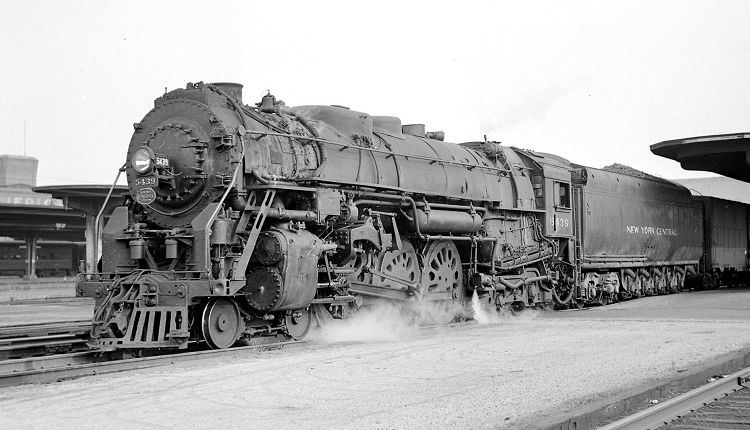
Sadly, in '47, after years of limited ridership and failure to generate ridership, the C&EI retired the Zipper and replaced it with the Cardinal. The Cardinal, which ironically used blue passenger cars with an orange stripe, used the Zipper's route but was heavily decontented, using only a baggage car and a couple coaches.
One of the more impressive, yet forgotten passenger trains was the South Wind. Inaugurated in 1940, the South Wind was a Chicago-Miami route passenger train operated jointly by Pennsylvania Railroad, Louisville & Nashville, Atlantic Coast Line and Florida East Coast. Billed primarily as a PRR train, the South Wind was an oddity. PRR primarily focused on their NYC-Washington D.C. trains, as well as their NYC-Chicago routes, although they did offer three distinct north-south Midwest routes: Chicago–Indianapolis–Louisville, Chicago–Cincinnati, and Chicago–Columbus. Chicago-Florida routes were not without precedent though; C&EI/L&N/Nashville, Chattanooga & St. Louis/ACL had operated the Chicago-Jacksonville Dixie Flyer as early as 1885. Illinois Central had offered the Chicago-St. Louis-Jacksonville Seminole in 1909 over the Central of Georgia. PRR had even offered the Southland in 1915, which went to Jacksonville over the L&N and CofG.

By 1940, the two major players in the Chicago-Miami route were the Illinois Central's City Of Miami and Florida East Coast's Dixie Flagler. The City Of Miami, pulled by an EMD E6A painted in green and orange with red stripes, left Chicago on the Illinois Central, then crossed over to the Central of Georgia in Birmingham, Alabama before hopping onto the Atlantic Coast Line at Albany, Georgia. Florida East Coast then took over at Jacksonville and hauled it the last leg into Miami. The City of Miami route was 1,493 miles and the train made 25 stops en route, only one of which was for an engine change. In spite of the number of stops the train averaged at least 50mph over the 31 hour timetable

The Florida East Coast's Dixie Flagler left Dearborn Station in Chicago behind Chicago & Eastern Illinois' shovelnosed streamlined Pacific, then transferred to the L&N behind one of their streamlined Pacifics from Evansville, Indiana to Nashville, TN. From Nashville to Atlanta via Chattanooga it operated on L&N subsidiary Nashville, Chattanooga & St. Louis to Atlanta. At Atlanta southeast to Waycross, Georgia it ran on the ACL's subsidiary Atlanta, Birmingham & Coast before transferring to the ACL mainline all the way to Jacksonville, where it changed hands to the Florida East Coast behind an EMD E6A for the remainder of the trip to Miami. Covering 1,454 miles over six railroads, it operated every third day, with a timetable of 31 hours 35 minutes southbound and 29 hours 20 minutes northbound.
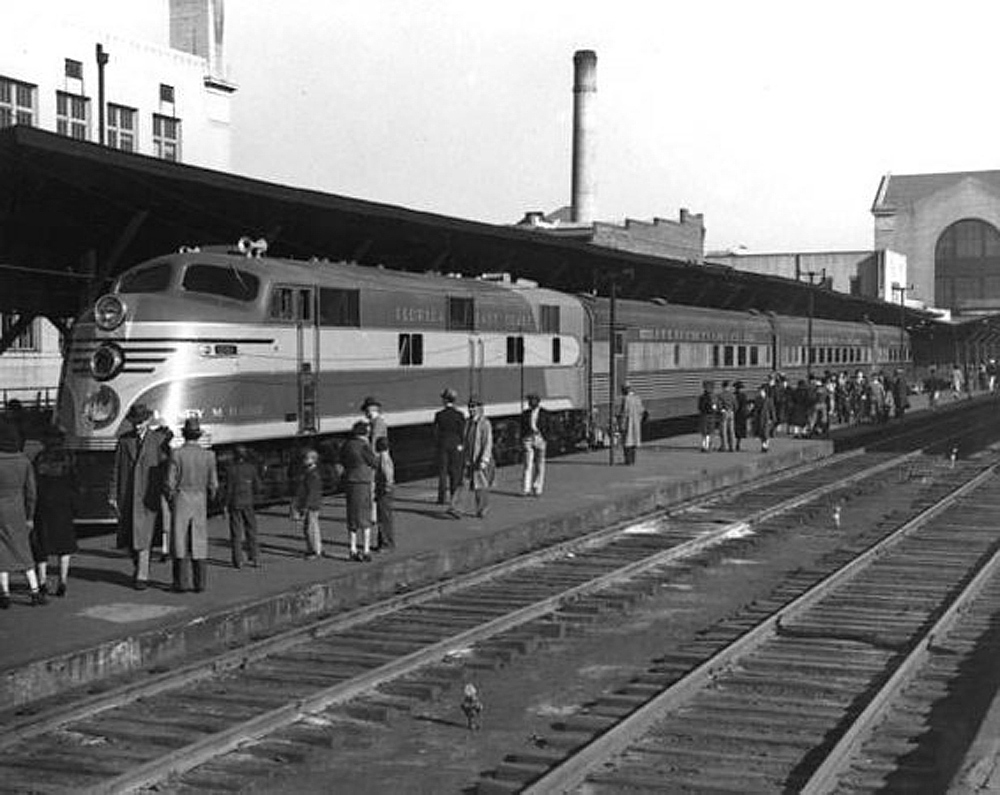
The popularization of southbound travel for warmer climes and the desire to get into this growing market led to the PRR deciding to create the South Wind. In 1939 they placed an order for 7 passenger cars from Budd, a baggage-dormitory-coach, four coaches, a diner, and a blunt-ended tavern-observation car. The passenger car order was a bit contentious, as PRR insisted they be painted in the traditional Tuscan Red with gold stripes. Budd was insistent that the cars looked best in bare stainless-steel and that prepping the stainless steel for paint required more effort and expense. PRR won out in the end, and the cars were delivered in PRR colors. Also, in contrast to City Of Miami and Dixie Flagler, which both had tropical-themed interior decorating, South Wind had the usual PRR interior fare. Hauled by one of two PRR K4s Pacifics in a simplified Loewy-designed streamlining, it cut a sharp figure.


Upon arriving in Louisville, the Louisville & Nashville coupled on one of their streamlined Pacifics. Built in 1919, they were overhauled and streamlined especially for the South Wind and Dixie Flagler. Particularly notable was #295, a one of one 3-cylinder Pacific. The L&N had found the third cylinder to be not worth the trouble and had parked the engine for most of the Great Depression and removed the extra cylinder during the overhaul. Painted black with a large white band with white pinstriping at first, it was later repainted to Tuscan Red with a gold stripe to fit in better. It retained the L&N's trademark huge headlamp with numbering written on the lens. Often overshadowed, they were still particularly attractive.


At Montgomery, Alabama it was taken over by the Atlantic Coast Line, who usually hooked up one of their USRA Pacifics and hauled it through Dothan, Thomasville, Valdosta and Waycross to Jacksonville.

At Jacksonville, Florida East Coast would hook up one of their tropically-colored EMD E3As to haul it the rest of the way to Miami.
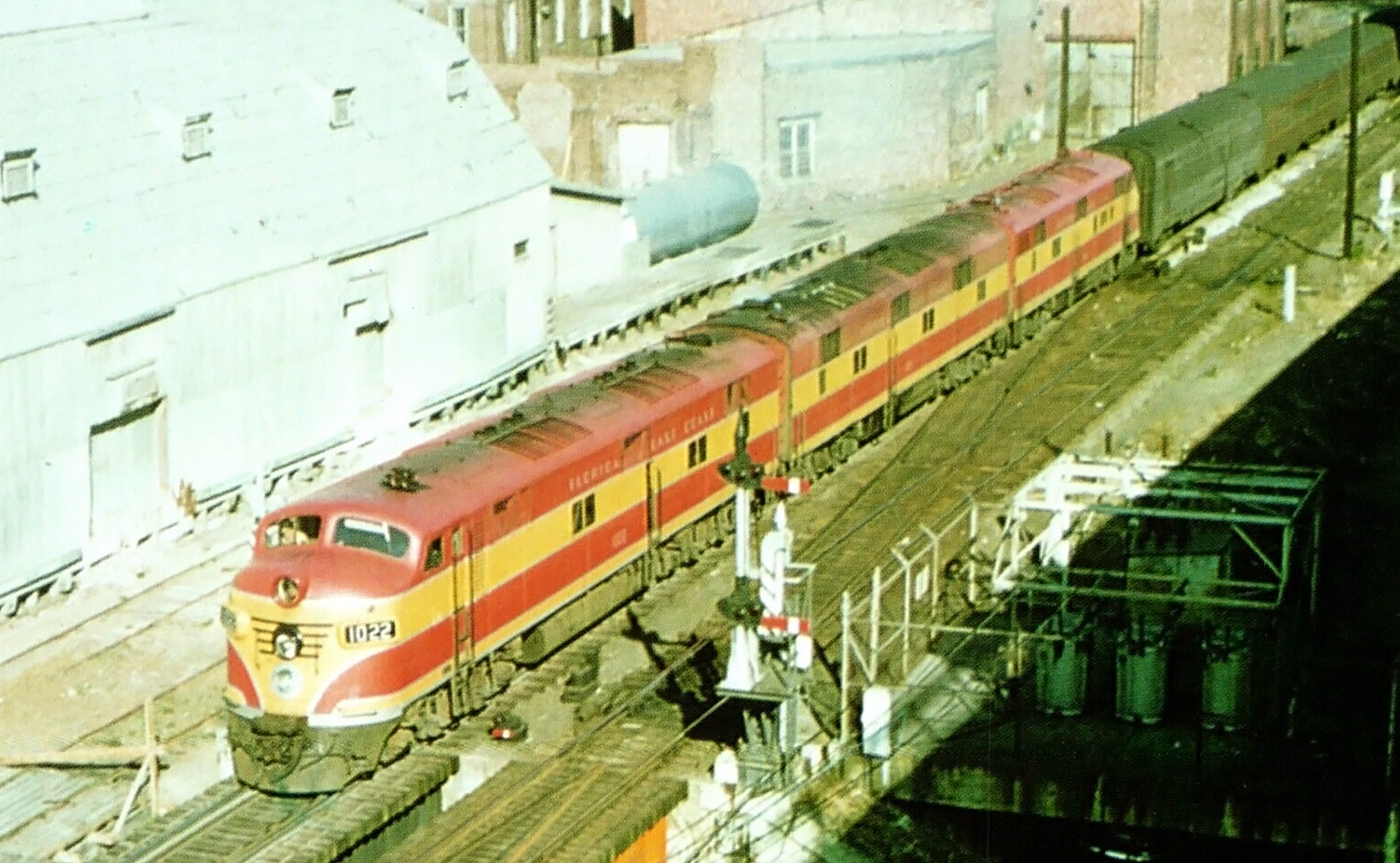
While the new streamliners’ end-to-end running times were identical, their average speeds varied due to the differences in the route mileage and the numbers of stop made by each. The South Wind made 16 stops during its 1,559-mile run, for an average speed of 53mph. Over the years, the train would make a number of changes. The most obvious was dieselization, at which point one set of cars was hauled the full length by PRR E-Units, while ACL E-units were used on the other trainset, cutting out L&N and FEC motive power (L&N locomotives were held in emergency reserve). They also added sleeper cars to the train and eventually added lightweight equipment that slowly turned the train fully bare stainless-steel (which had to have pleased Budd). The biggest change came in 1963, when a brutal strike on the FEC ended all passenger services on that railroad and instead used the Atlantic Coast Line's Jacksonville-Palatka-Tampa main line between Jacksonville and Auburndale and the Seaboard Air Line route from Auburdale to Miami. This was a glimpse into the Seaboard Coast Line merger in the future.

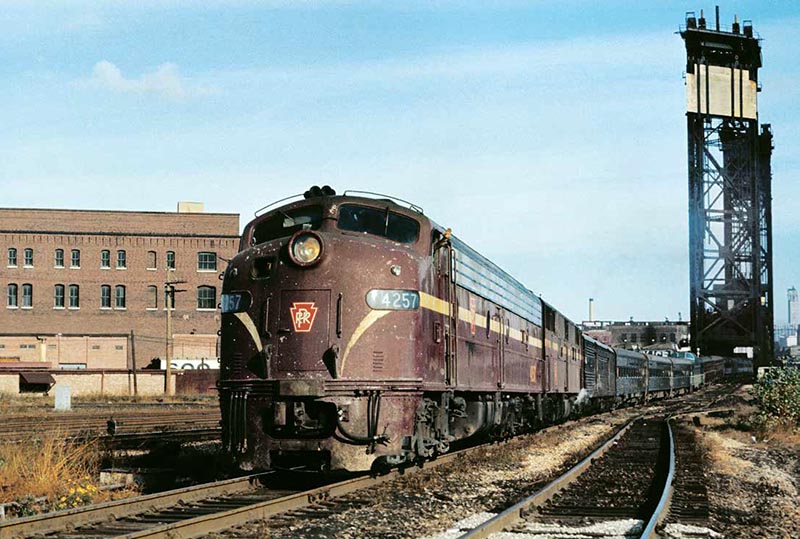
After the Penn Central merger, Penn Central became increasingly hostile towards their passenger operations, which were bleeding them dry. While the US government said that PC had to offer passenger service, PC made every effort to cancel or downgrade trains, particularly those outside of the Northeast Corridor. The South Wind was not excluded from this treatment and in 1969, the railroad that gave birth to the train dropped their end of the operation, offering a coach-only connection from Chicago to Louisville and leaving L&N and SCL to pick up the slack. Also, due to the poor condition of PC tracks, the connections were typically late, causing a cascade of delays throughout the rest of the trip. When Amtrak took over in 1971, they tried to fully restore the train's full operations, as well as making it a daily operation, instead of every third day. The train was also renamed from South Wind to Floridian.
Penn Central's continuously degrading track in the Midwest caused many delays, and finally in 1979, Amtrak threw in the towel and killed off the train, as it was unable to keep a resemblance to its schedule. By that point though, it had outlived its competitors. The Dixie Flagler had been renamed in '54 to Dixieland before being canceled in '57 (the Dixie Flyer was still operated over the same route but with a night departure, but was cancelled in '66) and the City of Miami had been canceled in '71 at the formation of Amtrak. Since then there has been no concrete effort to re-establish direct Chicago-Miami service, either on the route of the South Wind/Floridian or on that of its partners the City of Miami and Dixie Flagler, although the public has pushed strongly for it, since Louisville and Nashville have been left without Amtrak service.
In reply to NickD :
Growing up on the C&EI mainline & having ancestors who worked for the railroad, the Dixie Flyer was the train. Sadly, it was gone before I came around.
In reply to Pete Gossett (Forum Supporter) :
The C&EI's shovelnose streamlining on their Dixie Flagler/Dixie Flyer locomotive was better than the upside-down bathtub styling of some of the other railroads (Like NYC's Mercury and Union Pacific's #7002).

It's interesting that the Chicago-area railroads seemed to prefer the shovel-nose styling, compared to the bullet-nose styling of a lot of eastern roads.
Chicago & Northwestern had their E-4 Hudsons
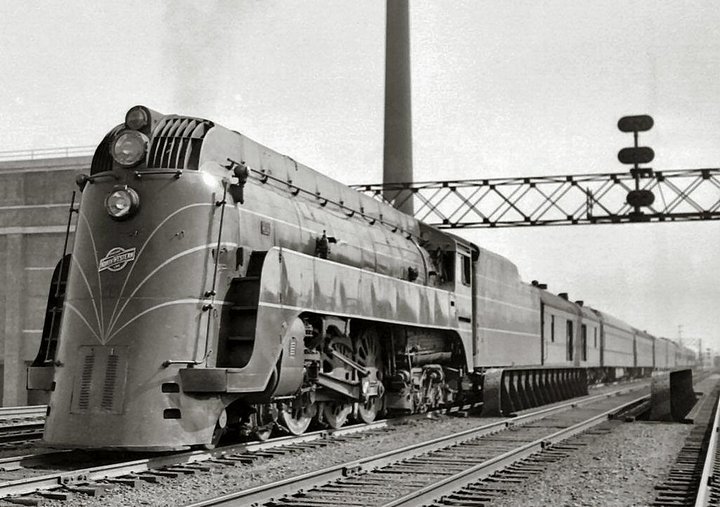
Milwaukee Road had their streamlined Hiawatha Atlantics, Pacifics and Hudsons
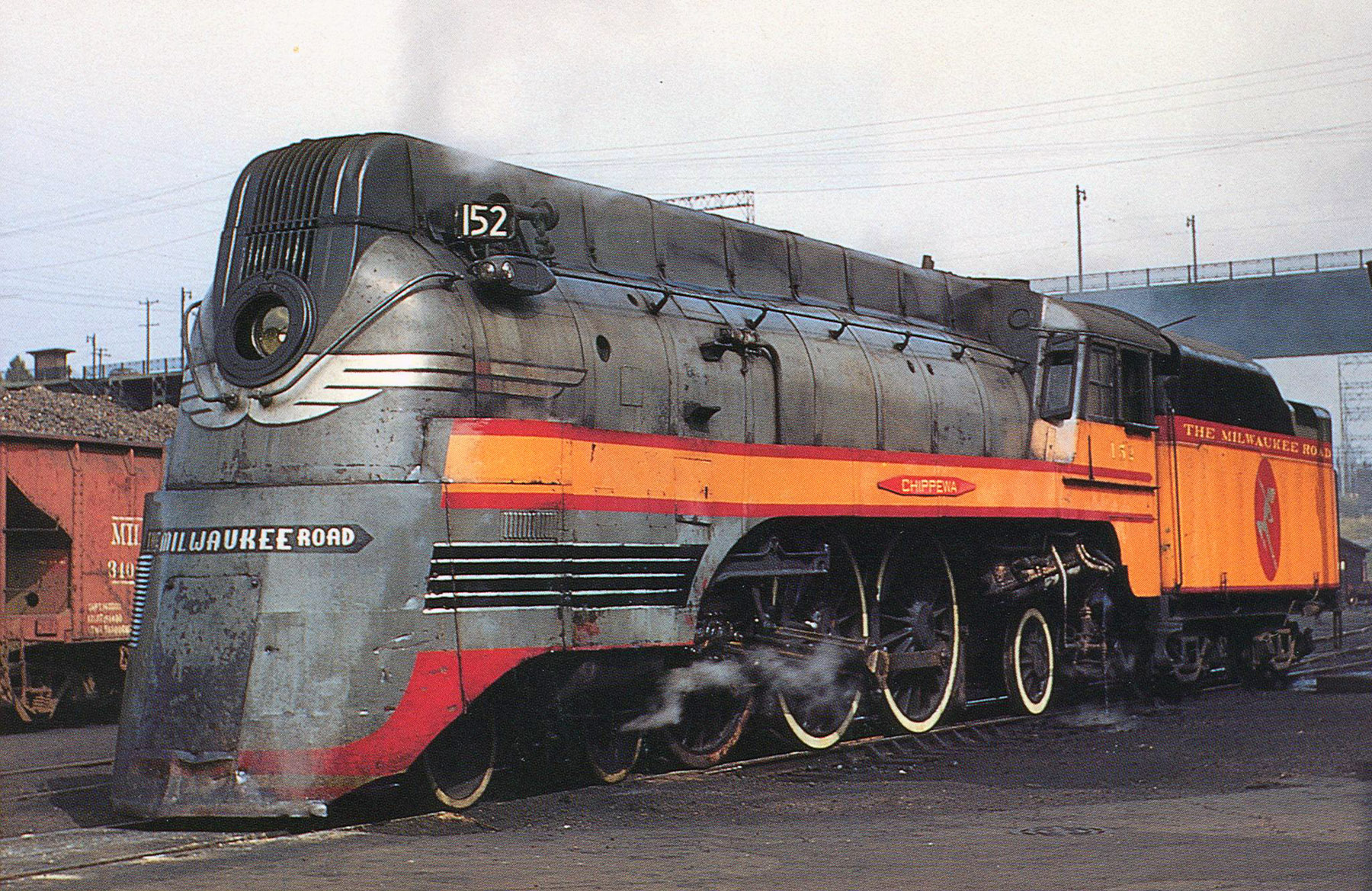 And Grand Trunk Western had their (homely) 4-8-4s
And Grand Trunk Western had their (homely) 4-8-4s

It's interesting just how dominant the Florida East Coast was in the long-haul passenger market into Miami. Not only were they running their own train in the Dixie Flagler/Dixie Flyer but they were handling the final leg's of both the competing trains. That's kind of a win-win-win. Granted, at that point, the perennially hard luck FEC really needed some good news. In 1905, anticipating Key West being a major port for ships coming through the Panama Canal, they begun had construction of the Florida Overseas Railroad, also known as the Key West Extension. As well as hoping to capitalize on trade with Cuba, FEC hoped that Key West would become a major loading and unloading point as well as a fueling depot for ships. The Key West Extension took seven years to complete, cost more than $50 million dollars and was hit by three hurricanes during its construction. Relying on debt peonage with immigrant workers, working conditions were so nightmarish and so many workers died that the Justice Department actually prosecuted the FEC for slave kidnapping laws. The fact that their working conditions were deemed horrendous enough even by 1910 standards to warrant prosecution should be an indicator of how bad things were. By the time the Key West Extension was complete, ship technology had advanced enough that ships no longer stopped for coal in Key West, eliminating the primary reason for existence.


Then, during the 1920s Florida real estate boom, the FEC gambled heavily. Finding themselves making money hand over fist, FEC spent a fortune on improving their physical plant, double-tracking almost their entire mainline, installing automatic block signalling and purchasing hordes of new Pacifics and Mountains. First the real estate bubble burst, then the 1929 Stock Market Crash and the Great Depression hit, forcing the FEC into bankruptcy and resulting in them selling off a lot of those brand-new steam engines (a bunch of FEC Mountains ended up in Mexico and operated there into the '60s) and then the 1935 Labor Day Hurricane wiped out large portions of the Key West Extension. Unable to afford to repair the Key West Extension, which had also never been as profitable as hoped, the FEC cut all the way back to Florida City and sold the extension's remains to the state who turned it into the Overseas Highway.

The long and short-haul passenger trains trying to get to Miami helped restore the FEC a little bit, although it was collateral damage in the Cuban embargo in 1962,and a new owner fought furiously to get the FEC out of bankruptcy and restore its deteriorating trackage. But then in '63, the FEC entered negotiations with non-operating unions. Rather than accept a nationwide union agreement, the FEC wanted to negotiate terms with the unions on their railroad to avoid featherbedding. But, the non-operating unions refused to accept the terms, resulting in a 14 year strike by the non-operating unions, as the railroad brought in workers to replace them. During these 14 years, bombings and shootings were frequent and in 1963, the railroad was forced to halt all passenger operations, which caused many of the long-haul trains it was handling to jump over to the Atlantic Coast Line. Passenger service, under the state's demands, returned in '65 and sputtered along intermittently until 1967 before finally being cancelled all together.
I have to wonder how many labour hours all that streamlining added to servicing the loco.
May have offset some of the advantages gained.
Is it true that the Pennsy never had a 4-8-4 Northern? I wonder how much money was wasted on all the experimental steam locomotives?
In reply to LS_BC8 :
Pennsy kind of had a 4-8-4 Northern. The T1 4-4-4-4 was not articulated, it was a rigid frame so it was technically a Northern just split in two.
Its worth pointing out that Pennsy's steam motive power thought processes were odd, to say the least. They completely ignored the invention of the feedwater heater, they were bullish on equipping power reversers even when the ICC mandated installing them, they largely shyed away from mechanical stokers even on their big I1sa 2-10-0s, they only briefyl dabbled in articulated engines, and other than their J1 2-10-4s (actually a C&O design) and their Duplexes, they never equipped their engines with 4 wheel trailing trucks. While the Belpaire boiler was largely a turn-of-the-century curiosity, PRR equipped almost every engine they owned with it. When headlights moved from the tops of smokeboxes to the center of the smokebox door, they kept them on top. While every other railroad found the 2-10-0 a design that was lacking almost immediatley upon its development, "too many mouths and not a large enough pantry" so to speak, PRR went on to own almost 600 of them, more of one arrangement than entire fleets of other railroads.
During the '20s and '30s, while many advancements were being made in steam locomotive configurations, the Northern, the Berkshire, the Texas, PRR was more focused on electric locomotive development. PRR actually hoped to electrify all of their operations, but soon discovered it was too pricey. But during this time they let their steam engine development stagnate. Since they had such a large roster (almost 3000 Consolidations alone!), rather than just develop newer, more powerful engines, they just found it more convenient to double up E6s Atlantics and K4s Pacifics on passenger runs or put fouir I1sa Decapods on iron ore trains.
The common development path for passenger locomotives was that the 4-6-2 Pacific came along and then railroads needed more power and they developed the 4-8-2 Mountain. Then the next phase for light passenger usage was to install a larger firebox and a 4-axle trailing truck on a Pacific and make a 4-6-4 Hudson and then eventually do the same to convert a Mountain to a 4-8-4 Northern for larger trains. PRR had the Pacific, boat loads of them in fact, and although they developed the M1 Mountain as a dual-service passenger engine, its estimated that only 10% ever pulled a passenger train. PRR skipped the Hudson, as, again, they had enough Pacifics to just doublehead instead.
They did actually look at the Northern, as their Pacifics eventually began to get overburdened. From12/6/44 through 1/3/45, they borrowed Norfolk & Western J-1 #610 and racked up approximately 7100 miles on her, including hauling the eastbound Broadway Limited on 12/8, 12/21, 12/29 and 1/1/45. Seeing the PRR's crack varnish being hauled by an N&W steam engine averaging 95mph on for 45 continuous miles must have been a sight to behold. They also did some extended high speed operation, hitting as fast as 110mph, impressive for a 70" drivered engine, before breaking the valve gear and having to cease testing. PRR's mechanical department was impressed with the engine but found the machinery speeds to high on the 70" drivers and that very little time was made up on trains of 16 or more cars. PRR seemed to have some sort of a beef with N&W engines, as they tested Class A 2-6-6-4s during WWII to be their new freight engine and then decided to go with the C&O's T1 2-10-4 instead.

PRR was also apparently concerned with hammer blows from the long rods required from an 8-drivered locomotive at higher speeds. A lot of railroads had had this concern as well (New Haven found that high-speed wheel slip on their I-5 Hudsons would actually bounce the drive wheels off the rail) but by this time the problem had largely been addressed by using lightweight materials and precision balancing. Still, PRR's though process of a 4-4-4-4 would be that it would be using two sets of much shorter rods, which would be lighter and easier to balance and have less revolving and reciprocating mass. They also stepped up the drive wheels from 70" to 80" and installed oscillating cam valve gear to lower machinery speeds and reduce the chances of a valve gear failure at high speed operation.
 While they did end up being faster and more powerful than the N&W J engine, they were gutless down low and struggled with grades. The T1 didn't really come alive until higher speeds. They were also prone to extreme wheelslip due to improper spring rigging and the more responsive valve gear. Engineers, used to less powerful engines with conventional valve gear, would be hamfisted with the throttle, making huge rapid adjustments, which would cause the T1 to break loose. There are videos of T1s traversing yards and one of the engines will slip and runaway. The valve gear was also rather fragile and difficult to maintain. N&W actually borrowed a T1 later on and did their own comparison against one of their Class Js. In their findings, except for at speeds above 65mph, the T1 was inferior. And on their road and others there was not enough uninterrupted high speed running or flat operation to warrant the tradeoff of the larger drivers and short stroke.
While they did end up being faster and more powerful than the N&W J engine, they were gutless down low and struggled with grades. The T1 didn't really come alive until higher speeds. They were also prone to extreme wheelslip due to improper spring rigging and the more responsive valve gear. Engineers, used to less powerful engines with conventional valve gear, would be hamfisted with the throttle, making huge rapid adjustments, which would cause the T1 to break loose. There are videos of T1s traversing yards and one of the engines will slip and runaway. The valve gear was also rather fragile and difficult to maintain. N&W actually borrowed a T1 later on and did their own comparison against one of their Class Js. In their findings, except for at speeds above 65mph, the T1 was inferior. And on their road and others there was not enough uninterrupted high speed running or flat operation to warrant the tradeoff of the larger drivers and short stroke.
Realistically, PRR likely would have been better off trusting Alco or Baldwin to build them a solid Northern along the blueprints of the N&W J or the Union Pacific FEF-3. Arguably their best freight engines, the J1 Texas, were the result of someone else's design. They tried to one-up the J1 with the Q2 4-4-6-4 Duplex and it barely performed better but with a lot more complexity and expense. But PRR was a bit haughty and arrogant about their own design and always thought they knew best. Was the T1 impressive? Sure. They looked awesome, hauled ass and were a technical marvel. Was it a good engine? Debatable. It certainly wasn't a great fit for PRR's operating condition. It likely would have been better served on the New York Central's flat "Water Level Route" or a Midwest route than on PRR's more mountainous terrain.
ShawnG said:I have to wonder how many labour hours all that streamlining added to servicing the loco.
May have offset some of the advantages gained.
A lot of times, bits and pieces were removed over time for that reason. Early on the NYC's Empire State Express Hudson had stainless steel skirting that covered the firebox and blended into the tender.
 Almost immediately the skirting over the firebox was ripped off the firebox by crews to make servicing easier, as you can see in the photo below. Also, by this point it had swapped over to a centipede tender without the stainless steel skirting. It also has an old heavyweight baggage car crammed in there.
Almost immediately the skirting over the firebox was ripped off the firebox by crews to make servicing easier, as you can see in the photo below. Also, by this point it had swapped over to a centipede tender without the stainless steel skirting. It also has an old heavyweight baggage car crammed in there.
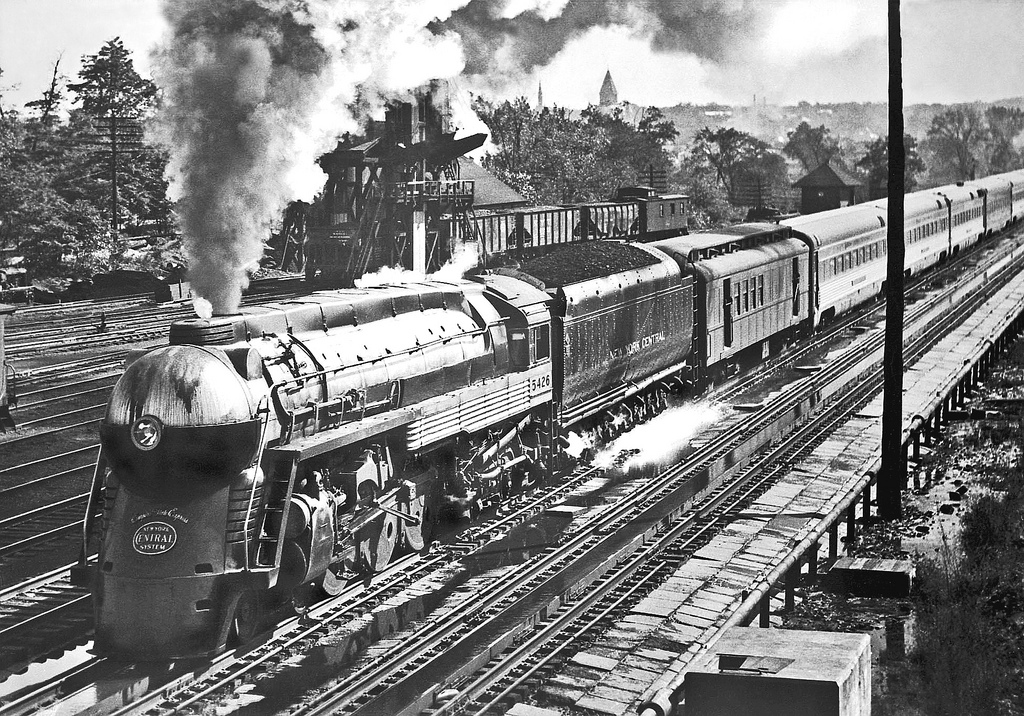
Shifting gears a little bit, I have a small mystery to solve. One of the cheap old cars I picked up is this 40 foot box car, with a strange feature. Namely this slot in the roof right down the walkway.

It's stamped "Mantua" on the bottom and it looks almost exactly like other Mantua-Tyco box cars I've seen, except for the slot. In fact, here's one with the exact same roadname and markings, but a normal roof.
I also noticed the inside had some weird stuff going on when I took it apart. It sort of looks like some kind of band-drive mechanism on each end:


I can't figure out what purpose this might have served. Maybe a little train worker running back and forth along the roof?
In reply to slowbird :
I think there used to be a car where a railroad cop chased a hobo across the top of the car while it rolled. Is it one of those missing the figures and some of the drive mechanism?
In reply to kazoospec :
I found something fitting that description, but it's a Lionel. But that gave me the idea to search for "animated boxcar" which brought up more useful results, including this page:
http://tycotrain.tripod.com/tycotrainsredboxaccessories/id25.html
which indeed shows a very similar concept, this time a brakeman going back and forth.
I doubt I'll find the parts to get this working again, but at least I understand it now. ![]()
Furthermore, I discovered the hilarious Giraffe car by Lionel, which I am now obsessed with:


A New York Central Mike or Console running up Washington Street in Syracuse, NY. Around '36, the Central ceased using this track after complaints of noise and cinders. Recently, while doing water main repairs in the area, Syracuse DPW actually unearthed rails and ties that had just been paved over repeatedly
You'll need to log in to post.